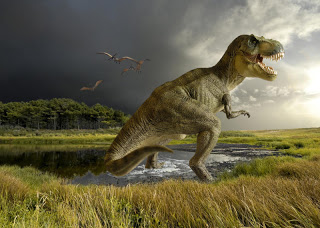
University of Adelaide research has shown new evidence that dinosaurs were warm-blooded like birds and mammals, not cold-blooded like reptiles as commonly believed.
In a paper published in PLoS ONE, Professor Roger Seymour of the University’s School of Earth and Environmental Sciences, argues that cold-blooded dinosaurs would not have had the required muscular power to prey on other animals and dominate over mammals as they did throughout the Mesozoic period.
“Much can be learned about dinosaurs from fossils but the question of whether dinosaurs were warm-blooded or cold-blooded is still hotly debated among scientists,” says Professor Seymour.
“Some point out that a large saltwater crocodile can achieve a body temperature above 30°C by basking in the sun, and it can maintain the high temperature overnight simply by being large and slow to change temperature.
“They say that large, cold-blooded dinosaurs could have done the same and enjoyed a warm body temperature without the need to generate the heat in their own cells through burning food energy like warm-blooded animals.”
In his paper, Professor Seymour asks how much muscular power could be produced by a crocodile-like dinosaur compared to a mammal-like dinosaur of the same size.
Saltwater crocodiles reach over a tonne in weight and, being about 50% muscle, have a reputation for being extremely powerful animals.
But drawing from blood and muscle lactate measurements collected by his collaborators at Monash University, University of California and Wildlife Management International in the Northern Territory, Professor Seymour shows that a 200 kg crocodile can produce only about 14% of the muscular power of a mammal at peak exercise, and this fraction seems to decrease at larger body sizes.
“The results further show that cold-blooded crocodiles lack not only the absolute power for exercise, but also the endurance, that are evident in warm-blooded mammals,” says Professor Seymour.
“So, despite the impression that saltwater crocodiles are extremely powerful animals, a crocodile-like dinosaur could not compete well against a mammal-like dinosaur of the same size.
“Dinosaurs dominated over mammals in terrestrial ecosystems throughout the Mesozoic. To do that they must have had more muscular power and greater endurance than a crocodile-like physiology would have allowed.”
His latest evidence adds to that of earlier work he did on blood flow to leg bones which concluded that the dinosaurs were possibly even more active than mammals.
Note: The above story is reprinted from materials provided by University of Adelaide.










